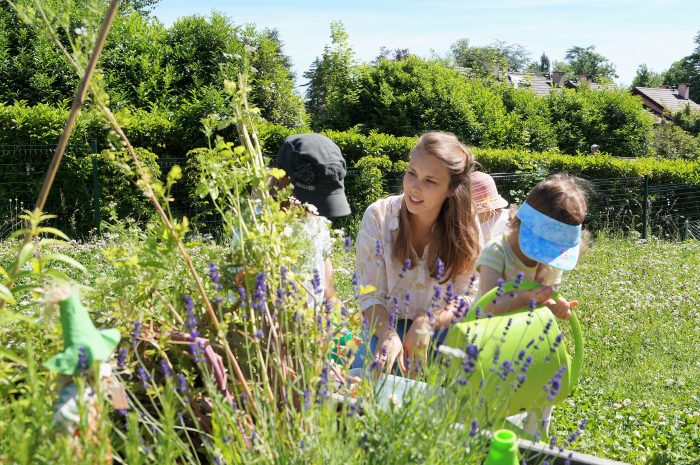
Getting out and about in the garden is a really fun way of helping children to learn more about the world around them. Growing and tending to plants and flowers or even just examining leaves and soil helps little ones start to understand about life cycles and where food comes from. At Little Green House we love our garden and forest projects and enjoy the time spent outside with your children!
If you would like to cultivate your own indoor or outdoor garden with your child at home, here are a few ideas how to make this a rewarding experience.
You don’t even need to have an outdoor space to enjoy gardening with your child. A great way to introduce them to gardening and the outdoors is by simply planting a little packet of seeds or some herbs and growing them in a pot or window box.
If you do have a garden, you could give your child a section to plant and look after. Ensure their plot gets plenty of sunshine, keep an eye on their seedlings and choose a few different seeds to plant to try to avoid disappointment with your little one if seeds don’t flourish, or some easily perish.
Top tips
Quick start your gardening
A great way to start is to plant quick-sprouting seeds so that impatient little ones can see the results of their hard work without much waiting around; sunflower, cress and salad seeds provide really easy results.
Herbs and veg
Once you’ve mastered these, herbs such as basil and mint or vegetables such as tomatoes or lettuce are a fantastic next step. Having your child cook with their own herbs and vegetables is not only highly rewarding and helps them to learn where food comes from but can also be a great way to encourage fussy eaters to try new foods!
Stimulate the senses
Planting in the garden is a great way to stimulate your child’s senses of touch, sight, sound, taste and smell – soft flowers, bushes and plants that rustle, strong smells and bright colours all help to enrich your child’s experience of gardening.
Mini tools
If your little one really loves getting out and about in the garden it can be helpful to buy a set of child-friendly mini-tools that they can hold and use by themselves. Having a little watering can, rake, trowel and spade can help build your child’s sense of independence as well as their physical movement and fine motor skills.
Keep your little one interested
Your toddler may become completely engrossed in gardening with you. However, be prepared for the fact that they may have a limited attention span and won’t be absorbed for more than a few minutes at a time. It’s a good idea to keep things simple and have other activities up your sleeve to extend your child’s interest.
- Get your children to make plant labels to mark where and what seeds have been planted.
- Go on a hunt for minibeasts (e.g. snails, worms and insects).
- Explain how bugs and creepy-crawlies are good for the soil and plants.
- Encourage them to hold these creatures gently and carefully so that they can see what minibeasts look like.
- Make a compost heap and explain to your child what you can and can’t put in there.
Ask questions
Keep them involved throughout the process and ask lots of questions so that they feel like they’re actively involved. Ask them where they think would be a good spot for their plants and why, how long they think their plants will take to grow and what they might look like.
What next?
While their seeds are growing, keep them interested in the garden by watching a bean begin to sprout. Take a few sheets of a kitchen roll, wet them and roll them inside a pint glass or tall jar. Drop a bean seed down the side and watch as the bean sprouts roots. It’s a great way of showing children what’s happening underground.
Getting down to it
Set aside some old clothes as your child’s ‘gardening clothes’. Working in the earth and soil has a high mess factor that children love so it’s a good idea to wear something that you don’t mind them getting messy.
Don’t forget sun cream and sun hats. Even on days that aren’t particularly sunny little ones still need skin protection – especially in the middle of the day.
Take photos or draw pictures of your plants with your little one at the different stages of bloom. Something like a sunflower works well to show your child how amazing the process of gardening can be. Stick the pictures in a scrapbook to help your child remember the process of planting and growing, and to remind them how far their plant has come.
This article has been found on and adapted from the BBC’s CBeebies site.
